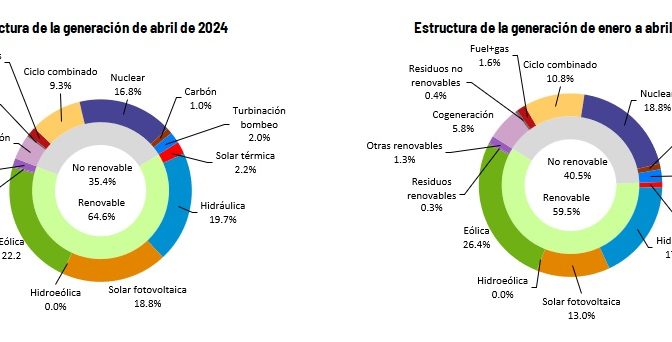In April, renewables reached a share of 64.6% of the total monthly generation and, for the first time, three renewable technologies lead the mix: wind (22.2%), hydraulic (19.7%) and solar photovoltaic ( 18.8%), Electricity demand grows by 6.3% in the Balearic Islands and 4.7% in the Canary Islands, once the effects of work hours and temperatures are taken into account. The demand for electrical energy in Spain increases by 0.9% in April.

National electricity demand experienced an increase of 0.9% in April compared to the same month of the previous year, once the effects of temperature and work hours were discounted. In gross terms, a demand of 18,938 GWh is estimated, 4.2% higher than that of April 2023.
In the first four months of 2024, Spain has registered a demand of 81,661 GWh, 0.7% more than in the same period of 2023.
This month, renewables generated 13,515 GWh, 21% more than in April 2023, and reached a share of the total of 64.6%, this being the first month in history in which three renewable technologies lead the Spanish mix : wind (22.2% of the total), hydraulic (19.7%) and solar photovoltaic (18.8%).
Thus, according to the provisional data available today, wind power is the leading technology for the seventh consecutive month with 4,643 GWh generated, followed by hydraulic power (4,112 GWh), which almost triples the production of the same month of the previous year. For its part, the third source in April was solar photovoltaic, which increased its production by 4.4% compared to the same month in 2023, and produces 3,940 GWh.

It should be noted that on April 24, solar photovoltaic broke its daily production record with 178 GWh; while on April 28, this technology achieved its highest share of participation in the national generation structure, with 24%.
With this boost from renewables, 83.1% of the electricity produced in Spain during the month of April 2024 was free of CO2 equivalent emissions, the highest monthly quota since records began.
Peninsular demand increases 0.6%
At the peninsular level and once the effects of work and temperature are taken into account, demand has been 0.6% higher than in April 2023. In gross terms, demand this month has been 17,754 GWh, 4% higher than that of the same month of the previous year.
In the first four months of the year, peninsular demand has been 76,946 GWh, 0.6% higher than that registered in 2023.
The set of peninsular renewables generated 67.2% of the total in April, according to provisional data available today, which shows a production of 13,325 GWh, 21.3% more than in the same month of the previous year. For their part, emission-free technologies contributed 86.7% of the total.
The peninsular generation structure in April is also led by wind power, which has been responsible for 22.9% of the total, producing 4,546 GWh during this month.
The electrical system in the Balearic Islands and Canary Islands
In the Balearic Islands, electricity demand in April was 6.3% higher than in the same month of 2023, once the effects of work hours and temperatures are taken into account. Thus, gross demand is estimated at 436,242 MWh, 7.5% more than April of the previous year. In the accumulated amount of the first quarter of 2024, the Balearic gross demand is estimated at 1,716,772 MWh, 0.8% more than in the same period of 2023.
In terms of generation, the combined cycle, with 65.5% of the energy produced in the Balearic Islands, was the islands’ first source this month. For its part, renewable energy without CO2 equivalent emissions generated in the Balearic community represented 17.9% of the total, the largest share recorded in the archipelago. Balearic renewable production grew by 17.6% in April compared to the same month of the previous year, reaching 58,481 MWh.
Furthermore, the submarine link between the Peninsula and Mallorca contributed during this month to covering 25.1% of the Balearic electricity demand.
For its part, in the Canary archipelago, the demand for electrical energy grew by 4.7% compared to the same month in 2023, taking into account the effects of work and temperatures. In gross terms, demand was 716,020 MWh, 5.9% more. In the first four months of 2024, Canarian demand is estimated at 2,872,468 MWh, 4.2% more than in the same period of 2023.
Regarding electricity generation in the Canary Islands, the combined cycle, with 46.2% of the total, was also the first source in April. Renewables and emission-free technologies reached a share of 18.3% of production, with the wind contribution being 13.5%.


